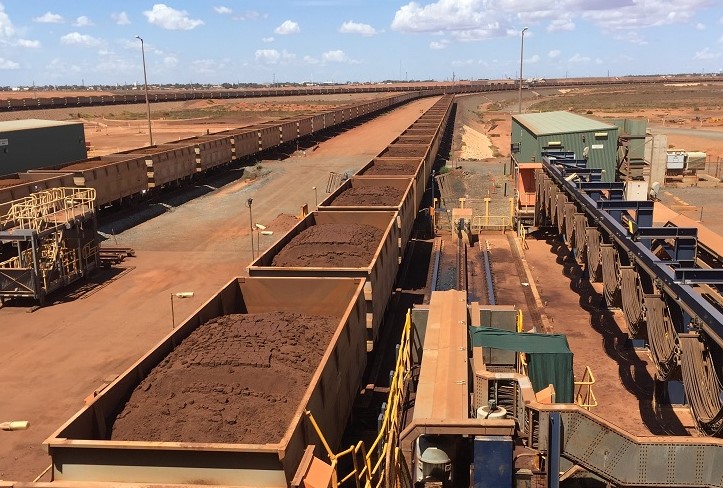
Where would we be without steel? From paper clips to trains to hip implants, steel is an important global commodity that is part of our everyday lives.
However, every tonne of steel produced in 2018 emitted on average 1.85 tons of carbon dioxide, equating to about 8 percent of the world’s carbon dioxide emissions.
The steel and aluminium industries in Australia employ thousands of people. To support livelihoods, new industries and a reduction in carbon emissions, the Low Emissions Technology Statement highlights the importance of environmentally sound ways to manufacture steel and aluminium.
What is ‘green’ steel and aluminium?
The terms ‘green steel’ and ‘green aluminium’ refer to sustainable, low-carbon methods to produce these metals. It involves using less carbon and more energy efficient processes, resulting in lower emissions.
Keith Vining, CSIRO Research Group Leader for Carbon Steel Materials Mineral Resources, said most of the world’s steel is produced from iron ore using a blast furnace and a basic oxygen furnace. However, as the world transitions to a low carbon economy, this processing route could evolve.
“Using a blast furnace produces metallic iron from primarily metallurgical coke for heating and reduction of iron oxide ore,” explains Mr Vining.
“Replacing carbon in the ironmaking value chain, with hydrogen for example, reduces the reliance on the metallurgical coke component.
“The integration of renewable energy at various points in the value chain to meet the energy needs for steel production could also transform the way steel is produced, making it a more sustainable product.”
How can green steel reduce emissions?
Producing steel using more sustainable methods has the potential to reduce Australia’s cumulative emissions by around 200 Mt CO₂-e to 2040.
Exporting these products to meet demand could help reduce international emissions cumulatively by over 500 Mt CO₂-e over the period to 2040.
“Production could rely less on carbon initially from natural gas, and then clean hydrogen. In the future, electric arc furnaces, which can be powered by renewable electricity, will increase in usage as blast furnaces are decommissioned,” Mr Vining says.
The Government’s goal through the Low Emissions Technology Statement is the delivery of low emissions steel production under $900 per tonne and low emissions aluminium under $2,700 per tonne. This will maintain current production with improved economic and environmental benefits.
It’s expected that direct reduced iron using natural gas will be commercially viable in Australia by 2030, with hydrogen steel-making available by 2040.
High quality, low carbon
For steel, our science is supporting sustainable metal production by improving the quality of the ore before it is shipped to the smelters through the processes of calcining, beneficiation, agglomeration and pre-reduction.
“These steps can reduce the energy consumption for the iron making process. Therefore, bypassing the sintering process of a traditional integrated iron and steel making plant,” explains Mr Vining.
“Longer term, these export products could form the feed for greener alternative iron and steel making processes.
“Renewable energy sources will also play a key role. Solar and wind farms will help spur iron ore producers to consider alternative opportunities to reduce their carbon footprint.
“Hydrogen is also part of the solution. Hydrogen is a reductant and can be used to reduce iron ore instead of relying on metallurgical coke."
What about aluminium production?
For aluminium, relying more on renewable electricity and more efficient smelter technology will reduce direct emissions. It’s also expected that electricity market reforms to improve grid efficiency and reduce costs will see bigger uptake by the aluminium industry to adopt new technologies.
Chris Vernon, CSIRO Senior Principal Research Scientist, Mineral Resources, said the manufacture of aluminium is a two-step process.
“The first step is the mining of bauxite ore and chemically refining this to alumina, a pure aluminium oxide. The second step involves dissolving the alumina in a bath of molten sodium aluminium fluoride, passing electricity through it and using a consumable carbon anode to produce aluminium,” explains Dr Vernon.
“The refining to alumina, known as the Bayer process, is over 100 years old and has been optimised incrementally to reduce the energy inputs. However, the process still consumes large amounts of electricity and coal or gas, as energy is required to make steam, pump fluids and stir tanks. A large amount of heat is also required to calcine the final product.
“Fortunately, alternatives are emerging in the form of renewable sources of energy to displace traditional fuels from the Bayer process.”
Alternatives for renewable green metal production
Solar thermal energy can be utilised directly to produce steam using commercially available technology. Renewable electricity is a potential co-product that can power pumps and other ancillary equipment.
“The calciner operates at temperature of up to 1000oC which can be challenging,” said Robbie MacNaughton, CSIRO Team Leader for Solar Thermal Processes, Energy.
“However, solutions are being developed such as solar fuels, where solar energy is used to produce a fuel suitable as a direct replacement for natural gas. There is even work underway looking at changing the way the calciner works to dramatically lower the temperature, enabling the use of direct solar thermal energy.”
Innovations to the smelting processes could also eliminate carbon anode from aluminium manufacturing.
Low carbon materials are one of five priority areas to drive a cleaner and more sustainable future for Australia. The other priority areas for the Low Emissions Technology Statement include battery storage, carbon capture and storage, hydrogen and soil carbon.
